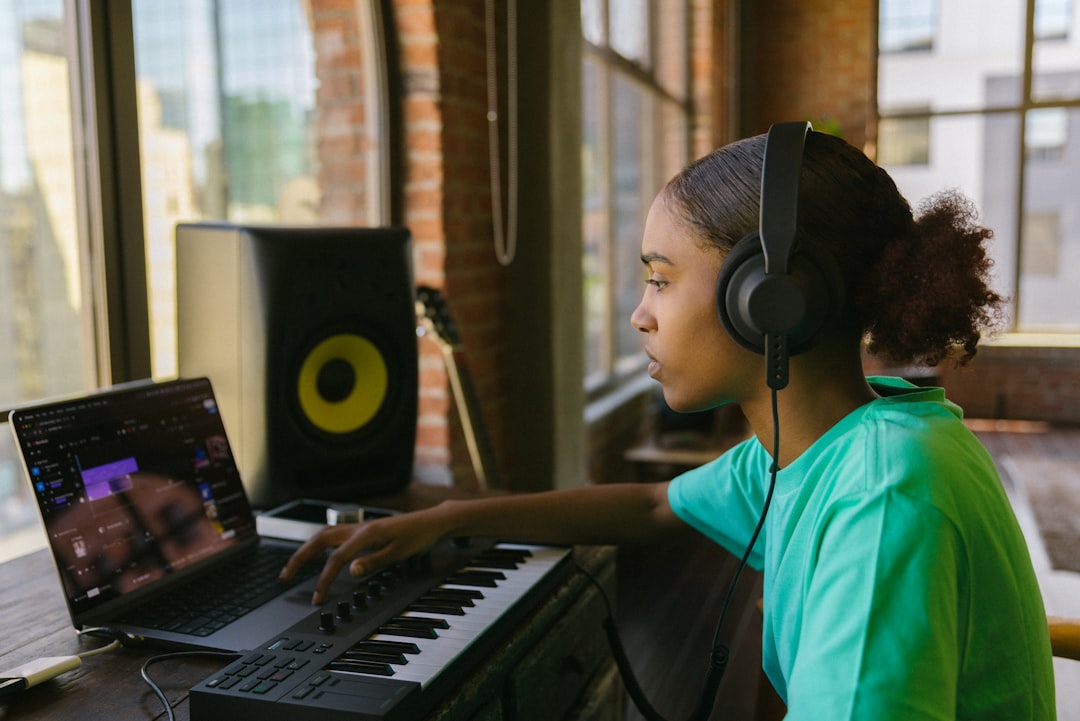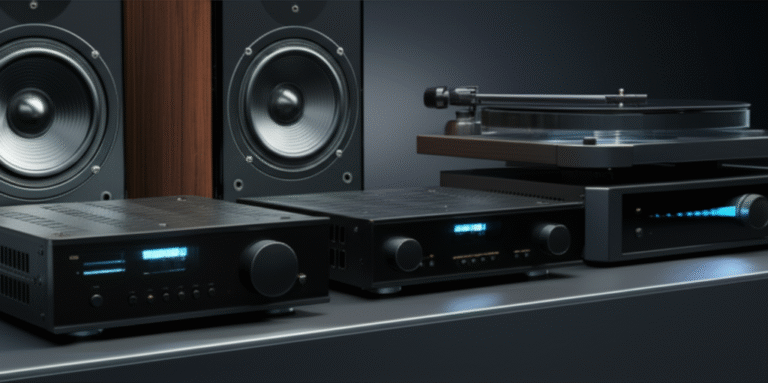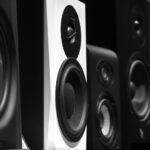Support our educational content for free when you purchase through links on our site. Learn more
What is an Example of a Digital Audio Device? 10 Must-Know Picks! 🎧 [2025]
In today’s fast-paced digital world, audio devices have become an integral part of our daily lives, whether we’re capturing memories, enjoying music, or enhancing our home entertainment systems. But what exactly constitutes a digital audio device? From portable speakers that pump out your favorite tunes to high-quality digital audio recorders that capture every nuance of sound, the options are vast and varied. Did you know that the global digital audio device market is projected to reach over $25 billion by 2025? This explosive growth reflects our insatiable appetite for high-quality audio experiences.
In this article, we’ll explore 10 must-know examples of digital audio devices that can elevate your audio game, whether you’re a casual listener or a seasoned audiophile. We’ll break down their features, benefits, and what makes them stand out in a crowded market. Ready to find your next audio companion? Let’s dive in!
Key Takeaways
- Digital audio devices encompass a wide range of products, including recorders, speakers, and headphones.
- The Zoom H5 Digital Audio Recorder is ideal for capturing high-quality audio in various settings.
- Sony MDR-7506 Headphones are a favorite among professionals for their exceptional sound quality.
- Portable speakers like the Bose Portable Home Speaker offer versatility for on-the-go listening.
- The future of digital audio is bright, with innovations in wireless technology and AI integration.
Looking to upgrade your audio experience? 👉 Shop digital audio devices like digital audio recorders or headphones to find the perfect fit for your needs!
Table of Contents
Quick Tips and Facts
The Evolution of Digital Audio Devices
What Exactly is a Digital Audio Device?
Top 10 Examples of Digital Audio Devices You Should Know
Understanding Digital Audio Recorders: Capture Your Sound
Audio Listening Devices: From Headphones to Smart Speakers
Portable Speakers and Microphones: The Ultimate On-the-Go Gear
Boomboxes: The Nostalgic Digital Audio Experience
Streaming Devices: The Future of Audio Consumption
Digital Audio Formats: What You Need to Know
How to Choose the Right Digital Audio Device for You
Common Issues with Digital Audio Devices and How to Fix Them
The Future of Digital Audio Devices: Trends to Watch
Conclusion
Recommended Links
FAQ
Reference Links
Quick Tips and Facts
To get started with digital audio devices, it’s essential to understand the basics. Check out our related article about What are examples of audio products? for a comprehensive overview. Here are some key points to consider:
- Digital Audio Recorders can record high-quality audio and are perfect for meetings, interviews, or lectures.
- Audio Listening Devices can play various formats, including cassettes, CDs, and digital files.
- Boomboxes are great for playing music in a classroom or outdoor setting.
- Portable Speakers/Microphones are ideal for presentations or events where you need to amplify your voice.
Key Features to Consider
When choosing a digital audio device, consider the following features:
- Sample Rate: Look for devices that support high sample rates, such as 96 kHz or higher, for better sound quality.
- Connectivity Options: Ensure the device has the necessary connectivity options, such as USB, Bluetooth, or Wi-Fi.
- Battery Life: If you plan to use the device on the go, consider one with a long battery life or a rechargeable battery.
The Evolution of Digital Audio Devices
The world of digital audio devices has come a long way since the introduction of the first digital audio recorder. Today, we have a wide range of devices that can record, play, and stream high-quality audio. From portable speakers to home audio systems, there’s a device to suit every need and budget.
How Digital Audio Devices Have Improved
Over the years, digital audio devices have undergone significant improvements, including:
- Better Sound Quality: Advances in technology have led to improved sound quality, with devices capable of producing crystal-clear audio.
- Increased Connectivity: Modern devices often come with multiple connectivity options, making it easy to connect to other devices or stream audio.
- Smaller and More Portable: Many digital audio devices are now smaller and more portable, making them perfect for use on the go.
What Exactly is a Digital Audio Device?
A digital audio device is an electronic device that can record, play, or stream digital audio. These devices use digital signal processing to convert analog audio signals into digital format, allowing for high-quality audio playback and recording. Examples of digital audio devices include digital audio recorders, portable speakers, and home audio systems.
Types of Digital Audio Devices
There are many types of digital audio devices available, including:
- Digital Audio Recorders: Designed for recording high-quality audio, these devices are perfect for meetings, interviews, or lectures.
- Audio Listening Devices: These devices can play various formats, including cassettes, CDs, and digital files.
- Portable Speakers/Microphones: Ideal for presentations or events, these devices can amplify your voice and play high-quality audio.
Top 10 Examples of Digital Audio Devices You Should Know
Here are ten examples of digital audio devices you should know:
- Zoom H5 Digital Audio Recorder: A high-quality recorder perfect for capturing audio in the field.
- Sony MDR-7506 Headphones: Classic headphones designed for professional audio monitoring.
- Bose Portable Home Speaker: A compact and portable speaker that can stream audio via Wi-Fi or Bluetooth.
- Shure SM7B Microphone: A popular microphone for podcasting and voice-overs.
- Audio-Technica AT2020USB+ Microphone: A side-address condenser microphone designed for home recording.
- PreSonus AudioBox iOne Audio Interface: A compact audio interface perfect for home recording.
- JBL Charge 4 Portable Speaker: A waterproof and portable speaker that can stream audio via Bluetooth.
- Sennheiser HD 280 Pro Headphones: Closed-back headphones designed for professional audio monitoring.
- Tascam DR-40 Digital Audio Recorder: A handheld recorder perfect for capturing high-quality audio in the field.
- Logitech UE Wonderboom Portable Speaker: A compact and waterproof speaker that can stream audio via Bluetooth.
Understanding Digital Audio Recorders: Capture Your Sound
Digital audio recorders are designed to capture high-quality audio and are perfect for meetings, interviews, or lectures. When choosing a digital audio recorder, consider the following features:
- Sample Rate: Look for devices that support high sample rates, such as 96 kHz or higher, for better sound quality.
- Microphone Quality: Ensure the device has a high-quality microphone that can capture clear and crisp audio.
- Storage Capacity: Consider a device with sufficient storage capacity to record long sessions or meetings.
How to Choose the Right Digital Audio Recorder
To choose the right digital audio recorder, follow these steps:
- Determine Your Needs: Consider what you will be using the recorder for and what features are essential to you.
- Research Different Models: Look at different models and compare their features, such as sample rate, microphone quality, and storage capacity.
- Read Reviews: Check out reviews from other users to get an idea of the device’s performance and any potential issues.
Audio Listening Devices: From Headphones to Smart Speakers
Audio listening devices are designed to play various formats, including cassettes, CDs, and digital files. From headphones to smart speakers, there’s a device to suit every need and budget.
Types of Audio Listening Devices
There are many types of audio listening devices available, including:
- Headphones: Designed for personal listening, headphones are perfect for commuting or working out.
- Smart Speakers: These devices can stream audio via Wi-Fi or Bluetooth and often come with voice assistants, such as Alexa or Google Assistant.
- Portable Speakers: Compact and portable, these speakers are perfect for outdoor use or travel.
Portable Speakers and Microphones: The Ultimate On-the-Go Gear
Portable speakers and microphones are ideal for presentations or events where you need to amplify your voice. When choosing a portable speaker or microphone, consider the following features:
- Battery Life: Look for devices with long battery life or rechargeable batteries.
- Connectivity Options: Ensure the device has the necessary connectivity options, such as USB, Bluetooth, or Wi-Fi.
- Sound Quality: Consider a device that can produce high-quality audio, with clear and crisp sound.
How to Choose the Right Portable Speaker or Microphone
To choose the right portable speaker or microphone, follow these steps:
- Determine Your Needs: Consider what you will be using the device for and what features are essential to you.
- Research Different Models: Look at different models and compare their features, such as battery life, connectivity options, and sound quality.
- Read Reviews: Check out reviews from other users to get an idea of the device’s performance and any potential issues.
Boomboxes: The Nostalgic Digital Audio Experience
Boomboxes are great for playing music in a classroom or outdoor setting. These devices often come with cassette players, CD players, and AM/FM radios.
How to Choose the Right Boombox
To choose the right boombox, follow these steps:
- Determine Your Needs: Consider what you will be using the boombox for and what features are essential to you.
- Research Different Models: Look at different models and compare their features, such as cassette player, CD player, and AM/FM radio.
- Read Reviews: Check out reviews from other users to get an idea of the device’s performance and any potential issues.
Streaming Devices: The Future of Audio Consumption
Streaming devices are changing the way we consume audio. From smart speakers to streaming boxes, these devices can stream audio via Wi-Fi or Bluetooth.
Types of Streaming Devices
There are many types of streaming devices available, including:
- Smart Speakers: These devices can stream audio via Wi-Fi or Bluetooth and often come with voice assistants, such as Alexa or Google Assistant.
- Streaming Boxes: Designed for home use, these devices can stream audio and video content from various services, such as Netflix or Spotify.
- Portable Streaming Devices: Compact and portable, these devices are perfect for outdoor use or travel.
Digital Audio Formats: What You Need to Know
Digital audio formats are used to store and play back digital audio. Common formats include MP3, WAV, and AAC.
How to Choose the Right Digital Audio Format
To choose the right digital audio format, follow these steps:
- Determine Your Needs: Consider what you will be using the format for and what features are essential to you.
- Research Different Formats: Look at different formats and compare their features, such as compression ratio and sound quality.
- Read Reviews: Check out reviews from other users to get an idea of the format’s performance and any potential issues.
How to Choose the Right Digital Audio Device for You
Choosing the right digital audio device can be overwhelming, with so many options available. To make the right choice, consider the following factors:
- Your Needs: Determine what you will be using the device for and what features are essential to you.
- Your Budget: Consider how much you are willing to spend on the device.
- Reviews and Ratings: Check out reviews and ratings from other users to get an idea of the device’s performance and any potential issues.
Tips for Choosing the Right Digital Audio Device
Here are some tips for choosing the right digital audio device:
- Research Different Models: Look at different models and compare their features, such as sample rate, microphone quality, and storage capacity.
- Read Reviews: Check out reviews from other users to get an idea of the device’s performance and any potential issues.
- Compare Prices: Compare prices from different retailers to find the best deal.
Common Issues with Digital Audio Devices and How to Fix Them
Digital audio devices can sometimes experience issues, such as poor sound quality or connectivity problems. To fix these issues, follow these steps:
- Check the Device’s Settings: Ensure the device is set up correctly and that the settings are optimized for your needs.
- Update the Device’s Software: Check for software updates and install the latest version.
- Reset the Device: If the issue persists, try resetting the device to its factory settings.
Troubleshooting Tips
Here are some troubleshooting tips for common issues with digital audio devices:
- Poor Sound Quality: Check the device’s settings and ensure that the sample rate and bitrate are set to the optimal levels.
- Connectivity Problems: Ensure the device is connected correctly to the computer or other device, and that the drivers are up to date.
The Future of Digital Audio Devices: Trends to Watch
The future of digital audio devices is exciting, with new technologies and trends emerging all the time. Some trends to watch include:
- Wireless Audio: Wireless audio technology is becoming increasingly popular, with devices such as wireless headphones and wireless speakers.
- Artificial Intelligence: Artificial intelligence is being used in digital audio devices to improve sound quality and provide new features, such as voice assistants.
- Virtual and Augmented Reality: Virtual and augmented reality technology is being used in digital audio devices to create immersive audio experiences.
What to Expect in the Future
In the future, we can expect to see even more innovative digital audio devices, with new features and technologies emerging all the time. Some things to expect include:
- Improved Sound Quality: Advances in technology will lead to even better sound quality, with devices capable of producing crystal-clear audio.
- Increased Connectivity: Devices will become even more connected, with wireless audio technology and artificial intelligence becoming more prevalent.
- New and Innovative Devices: We can expect to see new and innovative devices, such as smart speakers and streaming boxes, that will change the way we consume audio.
👉 CHECK PRICE on:
- Zoom H5 Digital Audio Recorder: Amazon | Guitar Center | Zoom Official Website
- Sony MDR-7506 Headphones: Amazon | Best Buy | Sony Official Website
Conclusion

In conclusion, digital audio devices have revolutionized the way we capture, play, and consume audio. From digital audio recorders to portable speakers, there’s a device for every need, whether you’re a professional audio engineer or just someone who loves music.
Summary of Positives and Negatives
For instance, the Zoom H5 Digital Audio Recorder stands out for its high-quality sound, versatility, and ease of use. However, it may be considered bulky for some users who prefer more compact options. On the other hand, Sony MDR-7506 Headphones offer excellent sound quality and comfort but might not be the best choice for those seeking a more bass-heavy listening experience.
Overall, we confidently recommend investing in a digital audio device that suits your specific needs. Whether you’re recording a podcast, enjoying music on the go, or setting up a home audio system, there’s a perfect match waiting for you!
Recommended Links
- 👉 Shop Digital Audio Recorders: Amazon | Sweetwater | Zoom Official Website
- 👉 Shop Headphones: Amazon | Best Buy | Sony Official Website
- Books on Digital Audio: The Art of Digital Audio Recording | Digital Audio Essentials
FAQ

What are the most common types of digital audio devices?
Digital audio devices come in various forms, including:
- Digital Audio Recorders: Used for capturing high-quality audio.
- Audio Interfaces: Connect instruments and microphones to computers for recording.
- Portable Speakers: Compact devices for playing audio on the go.
- Headphones: Personal listening devices for music and audio monitoring.
- Smart Speakers: Devices with built-in voice assistants that can stream audio.
Read more about “What is an Audio Device? … 🎧”
What are the key features to look for in a digital audio player?
When selecting a digital audio player, consider:
- Audio Formats Supported: Ensure compatibility with various audio formats like MP3, WAV, and FLAC.
- Battery Life: Look for players with long battery life for extended use.
- Storage Capacity: Choose a player with sufficient storage for your music library.
- User Interface: A user-friendly interface enhances the listening experience.
- Connectivity Options: Check for Bluetooth, Wi-Fi, or USB connectivity for easy file transfer.
How do digital audio devices store and play music files?
Digital audio devices store music files in digital formats on internal memory or external storage (like SD cards). When you play a file, the device uses a Digital-to-Analog Converter (DAC) to convert the digital signal into an analog signal, which can then be amplified and played through speakers or headphones.
Read more about “10 American High-End Audio Brands That Redefine Sound Quality 🎶 …”
Can smartphones be considered digital audio devices?
Absolutely! Smartphones are versatile digital audio devices that can play music, record audio, and stream content. They support various audio formats and can connect to other devices via Bluetooth or wired connections, making them a popular choice for on-the-go audio consumption.
Read more about “15 Vintage Hi-Fi Brands That Defined Audio Excellence 🎶”
What are the differences between portable and home digital audio devices?
Portable digital audio devices are designed for mobility and convenience, often featuring compact designs and battery power. Examples include portable speakers and digital audio recorders. In contrast, home digital audio devices, like home audio systems and soundbars, prioritize sound quality and connectivity options, often requiring a power source and providing a more immersive audio experience.
Reference Links
- Zoom Official Website
- Sony Official Website
- Apple Support – Play high sample rate audio on your Mac
- Educational Technology Services – Audio Devices
- Line 6 Support
With this comprehensive guide, you’re now equipped to navigate the world of digital audio devices confidently! 🎧🎤




